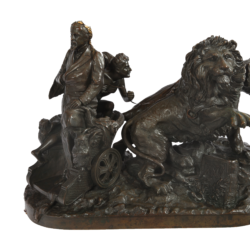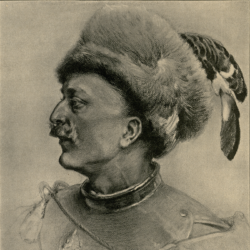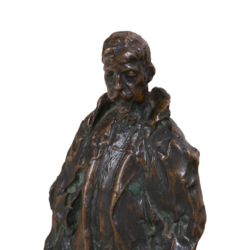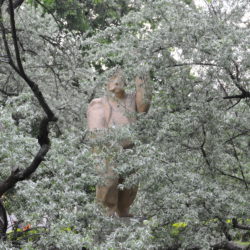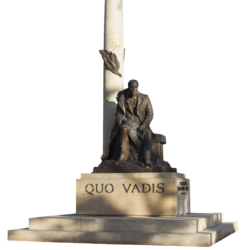
Denouement
Since 1989, monuments have continued to be erected in towns and cities related to the life and work of Sienkiewicz, but – at last – their list is completed with full-scale representations of the writer in Poland’s major cities as well. Chronologically speaking, the trend started in Warsaw with a sculpture by Gustaw Zemła (2000), followed by Zemła’s other art pieces in Vevey (2006) and Kielce (2010), not to mention Czesław Dźwigaj’s sculptures in Rome’s Villa Borghese gardens (joining the earlier bust of Sienkiewicz in 2006) and in Szczawnica (2008). As bench monuments have become a very popular form of commemoration in the past decade, the last Year of Henryk Sienkiewicz (2016) saw the installation of two of them in Łuków: one by Robert Sobociński, the creator of the Golden Uhlan equestrian statue in the nearby Kałuszyn[1]; and the other one in front of the local museum, carved in wood by Robert Sadło.[2] In addition, that year Kraków was finally given its first bust of Sienkiewicz. It could be said that this date, form, and location reflect the rather peripheral place the city occupies on the Sienkiewicz memory map – but what a symbolic location it is! Józef Opala’s bust of Sienkiewicz is displayed in Kraków’s Jordan Park among other, similar memorials (54 at the time of writing this article), between writer Zofia Kossak-Szczucka and Polish Underground Army commander Łupaszka, in the same lane with Cursed Soldiers (Polish postwar anti-soviet resistance) as well as numerous clergymen.
Yet another memorial that should be mentioned here is Zagłoba’s bench monument in Szczytna. The town lies in the Kłodzko Valley, close to the border with the Czech Republic, which could well be the reason why the Good Soldier Švejk sits on another bench just to the side of Zagłoba’s. The association between the two fictional characters is obviously based on their ribaldry, cowardice, and resourcefulness. This similarity seems a bit forced, superficial, and even trivial despite its certain comparative potential (after all, would you really like to join either of those for some holiday relaxation?). The next item on the list is the Bench Monument to the “Iron-Clad Cavalry” in front of the National Library in Warsaw, financed and installed in 2016 by the Zaczytani.org foundation as one of the capital city’s literary benches. Designed by Agata Kornhauser-Duda, First Lady of Poland, it was inspired by the Trilogy. As can be gathered from the name, the open book-shaped bench displays Polish Winged Hussars,[3] whose legend in its present form is largely attributable to Sienkiewicz.
Incidentally, most – if not all – recent monuments to Sienkiewicz, apart from benches and busts, represent him as an older man and in a sitting position as well. This is by no means a common way to depict writers, even novelists, and could suggest respectability and a degree of old-time glory as well as a rather literal acknowledgment of the long hours of sitting needed to produce all this copious fact and fiction writing.
As far as the form is concerned, the most recent wave of memorials stylistically belongs in the 19th century. One could even say that, apart from bench monuments, it includes some pieces of art that are genuine gems within this artistic convention. Such is the impression of many commentators and ordinary passers-by alike in the case of the Sienkiewicz statue by Zemła in Warsaw’s Royal Łazienki Park.[4] On May 3, 2000, Małgorzata Baranowska noted down, “The new monument in Łazienki is beautiful in its 19th-century style. A 19th-century Zemła, an art piece commissioned by the Porczyński family. Looks like it had always been there, covered in ivy, surrounded by greenery. It may be a good thing that Sienkiewicz and Chopin are out of sight of each other.”[5] Two days later, she continued: “Schools named after Sienkiewicz from all over Poland marched through Warsaw today. The most interesting thing about this gathering was probably the fact that the degree of boredom it offered was no different than the one experienced by students during a typical day at school. At least, it allegedly looked that way. Or it might have been just appearances. Regardless, all the Sienkiewicz schools attended the unveiling of their eponym’s monument. Some students wore historic costumes – straight from a rental shop.”[6] What is probably most notable here is the remark on the old-fashioned setting of the inauguration ceremony. It might have been very much in the spirit of Sienkiewicz, who even called himself a “Builder of Monuments,” but a few commentators reported it had a sort of distancing effect on today’s audience. This deadlock spotlights the persisting Polish problems not only with the format and design of public events but also with non-figurative art: Poles seem to find it difficult to adopt new solutions and are reluctant to select any form of memorialization but the representational one, particularly when a specific person is to be commemorated.[7] There can thus be no other outcome but either a successful likeness or a caricature.
Przypisy
- http://www.podlasie24.pl/lukow/region/laweczka-sienkiewicza-stanela-na-placu-w-lukowie-1cbe3.html, accessed on September 13, 2017.
- http://www.podlasie24.pl/lukow/region/kolejna-laweczka-sienkiewicza-w-lukowie-1db73.html, accessed on September 13, 2017.
- More details can be found at http://zaczytani.org/portfolio/znani-i-lubiani-artysci-tworza-dla-nas-zaczytane-lawki/, accessed on September 13, 2017.
- I. Grzesiuk-Olszewska, op. cit., pp. 216–217.
- M. Baranowska, “Prywatna historia poezji” [A private history of poetry], Twórczość 2000, vol. 8, p. 142; trans. J. M. Chopin’s statue is one of the park’s landmarks.
- Ibidem; trans. J. M.
- Cf. comments on the close-to-marginal effort to find “new form” in post-WWII monuments to Polish personages: I. Grzesiuk-Olszewska, Polska rzeźba pomnikowa w latach 1945–1995 [Polish monument sculpture, 1945–1995], Warsaw 1995, pp. 178–181.

